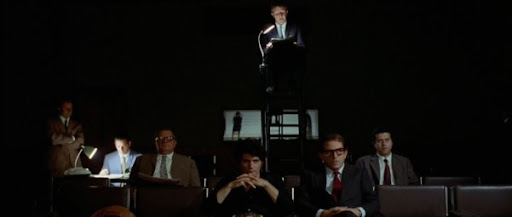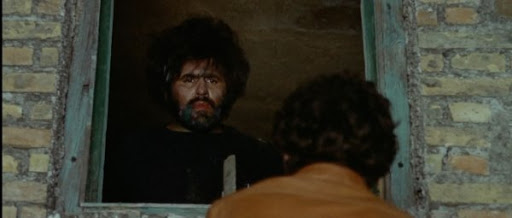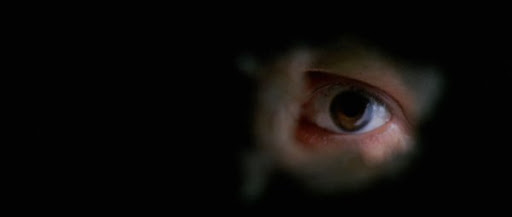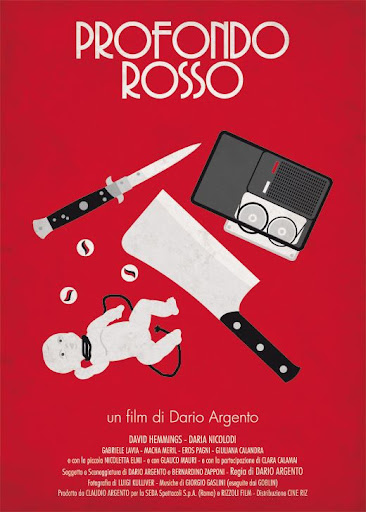
If my count is correct, this is the third BluRay Argento film we've posted. Damn, we're good.
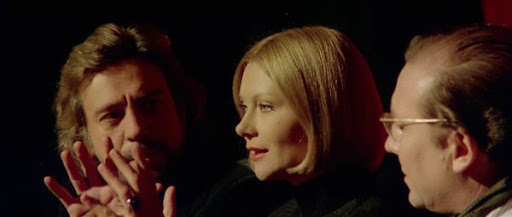
From Ed Gonzalez at Slant Magazine:
Deep Red was Dario Argento's first full-fledged masterpiece, a riveting thriller whose secrets carefully unravel via a series of carefully calibrated compositions that become not unlike virtual gateways into Freudian pasts. Like Argento's ever-flowing camera, Deep Red's killer is everywhere—the protagonist's claustrophobia becomes a physical response both to the film's oppressive mise-en-scène and Argento's formal framing. Unlike The Cat O' Nine Tails, there's no silly scientific rationale here for the film's murders (indeed, there are no easy answers). Argento delicately grapples with issues feminism and masculinity within Deep Red's meticulously visual exegesis of a troubled psyche. If the truth in Antonioni's Blowup was inscribed in a photograph of a potential crime scene, truth in Deep Red is stamped in the memory of pianist Marcus Daly (David Hemmings, also the star of the Antonioni classic). The film's murders are gorgeous to the point of distraction. This is Argento's intent though—to scare and awe the spectator so that he or she won't see the obvious. The film's final piece de resistance evokes the elusiveness of memory but, more importantly, shows that the identity of the film's killer was always available to the careful spectator.
If Ennio Moriccone's lullabies from The Cat O' Nine Tails seemed discordant, Deep Red's Goblin score is the perfect compliment to Argento's id-driven narrative. The film's recurring lullaby is one from the killer's troubled past, chillingly played on a handheld tape player before every crime. As the film progresses, the airiness of this music gives way to retro organ sounds that owe plenty to the legendary underground soundtrack to Vampyros Lesbos. A remarkable tableaux mort punctuates the film's opening credits as the menacing Goblin score is overwhelmed by the sounds of the lullaby. Argento's subversive static shot could be a snapshot torn from the pages of a Grimm photo album. A murder is committed (evoked merely by the dueling shadows of the victim and killer) in a room containing a table, a record player and a garish Christmas tree. A bloody knife falls to the floor and a child's feet step into the frame. (Interestingly, the scene brings to mind the opening sequence of John Carpenter's Halloween, released three years after Deep Red.) The lullaby fades out and the credits—here, standard white letters on a black background—recommence. Is this a scene from the past? Is it a dream? Is the child a girl or a boy? Did the child commit the murder? But even before you ask these questions, you might forget you ever witnessed this distant memory.

Argento's camera hypnotically zooms in on Marcus (Hemmings) after an unsuccessful jam session. Standing up, he utters: "Too clean. Yes, too precise. Too formal. It should be more trashy. This kind of jazz came from the brothels." This is perhaps the first instance of self-reflexivity in Argento's films. Indeed, part of Deep Red's success is Argento's ability to transcend the trashy material with the remarkable formalism of his camera. Before Marcus can even finish his speech, Argento begins to zoom into a room where a parapsychology conference is taking place. This steady accumulation of shots zooming in on their subjects is strangely unnerving, as if Argento is stealthily luring us into his world. Three figures are seated at a table on the auditorium's stage: the telepathic Mrs. Helga Ulman (Macha Méril), animal-enthusiast Professor Giordani (Glauco Mauri) and the supposedly clairvoyant Mario Bardi (Piero Mazzinghi). While Giordani's discussion on telepathy in animals may amount to little more than gibberish, it seemingly prefigures the themes that highlight and undermine Argento's Phenomena. Helga "can see thoughts just as they are formed" and is suddenly overcome with intense emotions. She mumbles something about a nursery rhyme, a house and a hidden body while envisioning a sharp knife entering her torso. There's a killer in the room (perhaps the killer from the film's opening flashback scenario?) and he/she will commit more murders. Joyously aware of his cinema as a kind of performance art, Argento zooms out of the conference and the door's surrounding red drapes close before the camera.
The film's camera pans over objects lying on a black table: a miniature crib being toppled by a marble, a voodoo doll made of red yarn, a child's drawing depicting a murder and a series of knives. More remarkable than the rich colors that highlight this scene and others like it are the psychoanalytic nature of Argento's close-ups. Argento likens the innocence of youth with killer objects, evoking the murder's troubled past. In one repulsive close-up, the killer applies mascara to one of his or her eyes. Is the killer a woman or, as a later scene may suggests, a transvestite? Helga is speaking on the phone with a friend when she hears the sounds of the film's nursery rhyme. Then, a knock on the door—it's the killer, who barges into the apartment even before Helga can run away. She is axed with such brutal and expert precision that Argento doesn't even allow her to ponder just how expertly he predicted her own demise. Argento's camera crawls over Helga's fabulous furniture (there's a table in the shape of the Star of David in one part of the room—during her funeral, it's revealed that she's Jewish) before the killer's gloved hands enter the frame and settle on Helga's notes. The killer must erase all evidence of the woman's premonition.
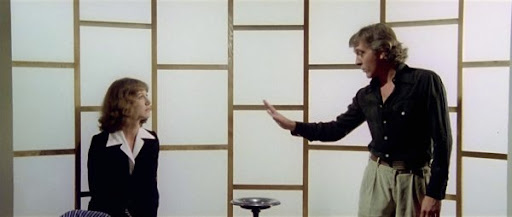
Just before Helga is killed, Marcus is seen having a conversation with his alcoholic best friend, Carlo (Gabriele Lavia). The men discuss politics, music and human survival before the grotesque statue of a Greek God hovering above a fountain. Marcus walks past the bar where he works as a performer, which Argento purposefully and eerily models after Helnwein's "Nighthawks" (a.k.a. "The Boulevard of Broken Dreams"). It's no coincidence that Argento chooses the Helnwein painting to emulate. Not unlike the painting's famous stars (Marilyn Monroe, James Dean), Argento's characters resemble ghosts. Not only does most of the film take place at night and the streets are barely populated. Even the few people that walk through the streets of Argento's ghost world come to resemble mannequins trapped in time. The Greek statue separates Carlo and Marcus during a conversation later in the film. Not only does the statue's nakedness serve to emphasize the honesty of their relationship but also seemingly anticipates the revelation of Carlo's homosexuality.
Marcus watches as Helga's face is thrust through a window and her neck is pierced with shards of glass. Marcus enters Helga's apartment (she lives below his own apartment) and pulls Helga away from the window. The hallway in Helga's apartment is lined with a series of small Munchian paintings. It is here that Argento forces the spectator to take on Marcus's point of view as the camera begins to track down the hallway. A small niche to the side of the hallway reveals a series of pale, gruesome portraits. Staring out onto the promenade below, Marcus sees a figure clad in black running from the building. Carlo drunkenly walks by the bar, seemingly oblivious to what has just transpired. Once the police arrive and Marcus makes his way down Helga's hallway, he comes to believe that a painting has been stolen from the apartment but seemingly pays little attention to this suspicion. Later, when Marcus and Carlo discuss the events, Carlo suggests the obvious: "But maybe the painting was made to disappear, because it represented something important." This missing painting, of course, is the ultimate clue to solving the identity of the film's killer though Argento doesn't call too much attention to David's trip down the hallway should the spectator solve the mystery entirely too early.

At the crime scene, Marcus is introduced to an overzealous reporter named Gianna Brezzi (Daria Nicolodi), who publishes his picture in the local newspaper, thus perpetuating the killer's pursuit of Marcus. Throughout the film, Argento seemingly challenges Marcus's masculinity through a series of comic encounters with Nicolodi's feminist construct. Carlo has already built a wall between himself and Marcus when he says, "I am the proletarian of the pianoforte while you are the bourgeois. You play for the sake of art and you enjoy it. I play for survival." It's no coincidence then that a police officer seems to ridicule Marcus for being a pianist. Marcus is defensive, saying: "You think playing the piano isn't a job? What is it then, a joke?" Marcus later tells Gianna that artists are very sensitive people while reporters have the hides of elephants. Gianna proclaims that she became a reporter in order to be independent from men while Marcus humorously acknowledges the source of his musical talents: "My psychiatrist would say that it's because I hated my father, so when I bang the keys I'm really bashing his teeth in." Though Marcus sets himself up as a sexist and a self-acknowledged weakling, Argento is more than willing to deflate his fragile ego. Gianna challenges Marcus to a round of hand wrestling—she beats him twice though he calls her a cheater on both occasions.
Looking for Carlo, Marcus makes small talk with his friend's mother, Martha (Clara Calamai). Before disclosing her son's location, the woman rambles on about an acting career that she once had to put on hold. On the walls are pictures from her supposed film career (the stills, in fact, are those from Calamai's early career in Italian cinema). Marcus finds Carlo inside his lover Massimo Ricci's (Geraldine Hooper) apartment. Carlo's secret is out and he's clearly resentful: "Good old Carlo, he's not only a drunk but a faggot as well." Since Marcus is so used to having his masculinity called into question, he barely bats an eye when he discovers Carlo's secret. Gay characters figure prominently in Argento films though they've never been revealed to be the film's killers. Since Argento suspects everyone equally, the spectator has to turn to his mise-en-scène for clues. A lesser director may have pegged Massimo as the Deep Red killer. Seeing as he is a transvestite, this would explain the earlier close-up of mascara being applied to an eye. Interestingly, Massimo is never heard from again. He is merely Carlo's considerate lover who just happens to be effeminate.

Argento's camera zooms back from an archway, pans up the outside of his stage-like apartment and zooms into his rehearsal studio. The camera then pans across the staff on Marcus's sheet music, revealing that the pianist is currently composing a song. Argento's hideously silent cinematic language remarkably evokes Marcus's claustrophobia. Marcus doesn't notice that plaster dust has fallen from the ceiling and onto his piano. Once Marcus realizes that someone was walking on the roof and has invaded his space (he knows because he can hear the lullaby), he continues to play his music in order to give the killer the illusion that he's lost in his music. With one hand he locks the door to his studio and calls Gianna for help. From outside the door the killer is heard whispering, "This time you're safe. But I'll kill you sooner or later." Once Marcus manages to secure an LP that contains the killer's lullaby, Professor Giordani recommends that Marcus read "Ghosts of Today and Legends of the Modern Age," by Amanda Righetti. Sitting inside an unusually spacious library chamber, Marcus reads from the book's first chapter ("The House of the Screaming Boy") and comes across a ghoulish tale of ghostly wails and haunting lullabies. Marcus believes this is a clue and begins to search for the house pictured inside the book.Amanda Righetti is about to pay the price for transcribing the killer's dangerous past. Stepping into her country house, she notices a toy baby hanging from a rope. Perturbed though not quite scared senseless, Amanda decides to stay inside her home. Soon the lights go out and Amanda's precious birds turn against her. Argento remarkable use of widescreen teases the spectator with the possibility that the killer can jump into frame any second—most remarkable is that the killer doesn't! Amanda dies inside her bathroom during a set piece that arguably remains Argento's greatest to date. Amanda's death is Argento's ingenious wink at the spectator.
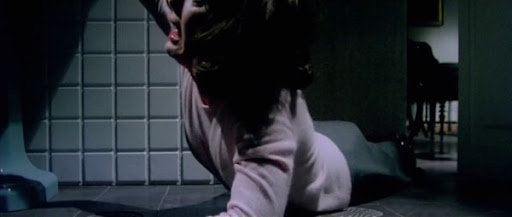
Emphasizing the nature of Deep Red as a literal puzzle, Argento fashions the woman's demise as a virtual clue waiting to be cracked. After smashing Amanda's teeth against the bathroom counter, the killer turns on the bathtub's hot water and gives the woman a deadly facial. Amanda falls to the floor and is left to scribble a last-minute note on her steam-coated linoleum walls.Marcus stumbles on Amanda's body and informs Giordani of the bizarre positioning of the woman's finger, almost as if she were pointing to something. Giordani doesn't give Marcus's observation a second thought until he arrives at Amanda's house. There he meets Amanda's maid, who cleans the blood off the bathroom sink. The anticipation is unnerving—how long will it take for Giordani to break the linoleum code? As the bathroom fills with hot steam emanating from the sink, the message on the wall reappears: "IT WAS." As if this anticipation weren't grueling enough, Argento continues to daringly leave the spectator in the dark. Argento's long shots truly evoke the pervasiveness of killer's reach. From the library to the Amanda's home, the killer is seemingly everywhere. Regardless of whether the killer spent the night at Amanda's or not is beside the point—Giordani is a dead man. Sitting in his study, Giordani witnesses a mechanical doll advancing in his direction. Why would the killer go to such bizarre lengths to kill Giordani? No matter. The doll shocks Giordani into submission—perhaps more frightening than his death is the way his bold-faced horror turns into smug self-satisfaction. Curiously, the doll's gangly movements seem to call attention to the rigorous nature of Argento's camera and Giordani's formal death.

Marcus stumbles upon "the house of the screaming child" pictured inside Amanda's book. After meeting the home's elderly caretaker, Rodi (Furio Meniconi), Marcus witnesses a strange transaction between the man and his young daughter. Slapped for what appears to be no reason, Olga (Nicoletta Elmi) laughs ghoulishly in appreciation. Argento pans down Rodi's legs and reveals a lizard struggling against death. Pierced by what appears to be a small sewing needle, the lizard seemingly dies as a consequence of living next to a house of demons. Some have made a connection between the lizard and Giordani's study of animal telepathy though I'd wager that the animal is little more than Argento's favorite reptile. (Lizards appear in Opera, Trauma and, most curiously, in Inferno while animal telepathy plays a key role in Phenomena.) Making his way into the house, Marcus discovers a child's gruesome drawing concealed on a wall covered in plaster. The drawing depicts the film's opening tableaux mort: a bloodied older man screams as a smaller figure prepares to stab him. In the background a Christmas tree keeps watch. To Marcus, the image suggests that the small child must now be the hatchet murderer.
While Marcus certainly has enough to go on, Argento once more winks at his audience. After Marcus leaves the room of the screaming child, a small portion of the wall's plaster falls to the ground revealing a missing piece of the puzzle: next to the dying man appears a third figure that seemingly partook in his Christmastime murder. Argento cleverly sets up a later set piece when Marcus drives past a group of trucks from the Road Assistance for Heavy Transportation. Looking closely at the picture of the home as it appears in Amanda's book, Marcus discovers that a room has been sealed off. How remarkable is it that Deep Red comes to resemble a 1000-piece puzzle slowly and coming together to reveal a horrifying secret? Marcus discovers a decayed body sitting on a chair (the man in the child's drawing) in the hidden room though he's unceremoniously knocked unconscious before he can make any sense out of this discovery. Marcus awakens with Gianna hovering above him, the mansion burning to pieces in the background. Judging by Gianna's grim expression, Argento teasingly suggests she might be the killer before she begins to take pleasure in the fact that she pulled him from the blaze. Remember: Deep Red is more than a virtual puzzle, it's also a game of sexual politics.
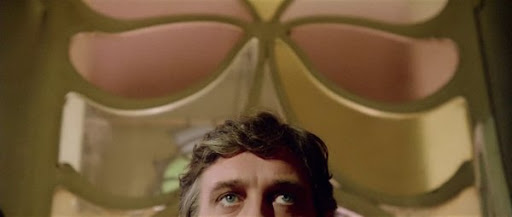
Gianna calls the fire department from Rodi's home and Marcus walks into Olga's room only to discover a picture hanging on her wall that is identical to the one drawn by the screaming boy. "She's a strange child. She likes the macabre," says Rodi to a dumbfounded Marcus. To Marcus, it's impossible of course for the girl to have drawn a painting so remarkably similar to that of the screaming boy's. Having seen the painting at the Leonardo Da Vinci School while she was cleaning up the archives, the girl unknowingly recreates the tortured past of the very boy who lived in the house next to her own. Once Gianna and Marcus make it to the school and find the screaming boy's sketch, a signature on the drawing seemingly links Carlo to the crimes. Even though Carlo stabs Gianna with his knife, the careful spectator already knows he is innocent. Remember: he was speaking with Marcus at the piazza during the time of Helga's demise. Standing before Marcus, a gun-wielding Carlo admits to the crimes before threatening to shoot his best friend. When the police arrive, Carlo runs into the street and is violently dragged to his death when his foot gets stuck on a hook attached to one of the Road Assistance trucks. Marcus, though, isn't convinced of Carlo's guilt and heads back to the scene of the original crime. There he comes in contact with the many faces of the film's killer but not before he's forced to displace memory into the present.
The elements of Argento's "animal trilogy" (The Bird with the Crystal Plumage, Cat O' Nine Tails and Four Flies on Grey Velvet) don't particularly lend themselves to explanations within any system of associations implied by the rest of the filmic experience. Deep Red's elements on the other hand work as a group collective, shaping and reshaping Marcus's view of reality as the film moves along. If Blowup is a film about the impossibility of perception, then Deep Red is entirely more hopeful. Marcus solves the identity of the film's murderer as he makes one final trip down Helga's hallway. What he first thought was a missing Munchian painting was indeed the killer's reflection on a mirror that still hangs in the niche adjacent to the hallway. (This fabulous revelation was always available to the spectator should they have been unfortunate enough to replay Marcus's earlier trip down the hallway using their rewind button.) Marcus makes the final connection just as he turns to greet the film's killer: Carlo's mother, Marta. She is the deluded biddy whose acting career was put on hold because of her husband's demands. Her resentment for the man led to his Christmas slaughter. Take Marta as Argento's doppelganger—the elaborateness of Deep Red's murders have sprung forth from the mind of a stifled artist and feminist. Marta's final performance is especially gruesome not because of the fabulous nature with which she meets her demise but because Marcus is forced to stare at his reflection in a pool of blood. Once again, Argento emphasizes the relentlessness of the gaze and the importance of "looking" in order to get the supreme truth.
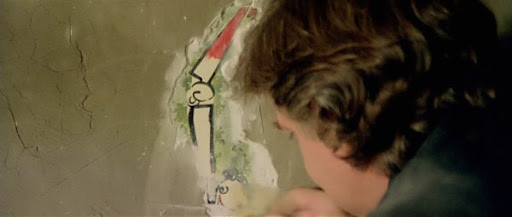
Technical Information:
Title: Profondo Rosso/Deep Red
Year: 1975
Country: Italy
Director: Dario Argento
Source: BluRay Retail
Video Codec: 720p-x264
Container: .mkv
Size: 8.08 GB
Length: 2:06:34
Programs used: Unknown
Resolution: 1280x572
Aspect Ratio: 2.35:1
Video: MPEG4 AVC H264 @ ~12500 kb/s
Frame Rate: 23.97 fps
Audio: Italian- Dolby AC3 5.1 @ 640 kb/s
Subtitles: English

(Use JDownloader to automate downloading)
Profondo Rosso Megaupload Links






